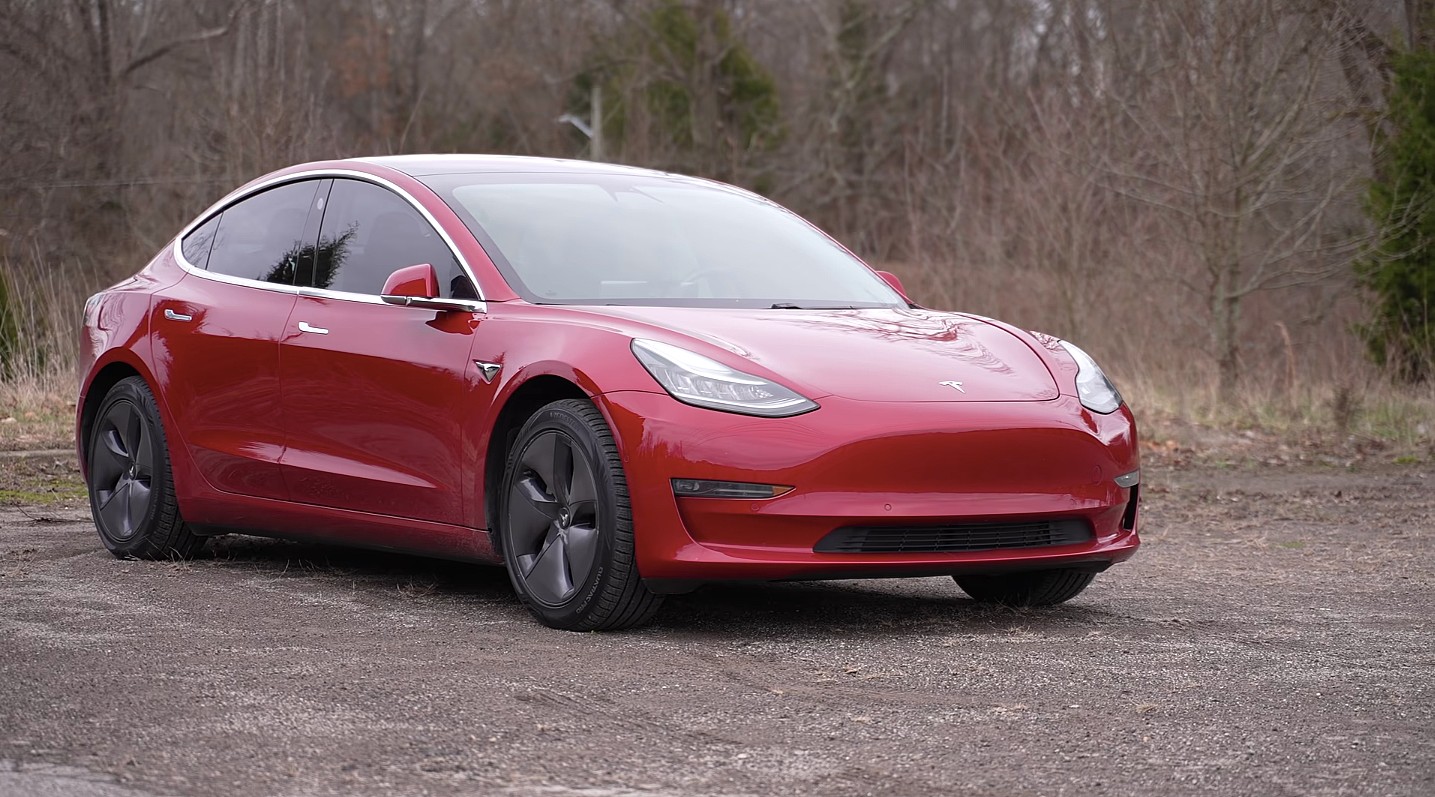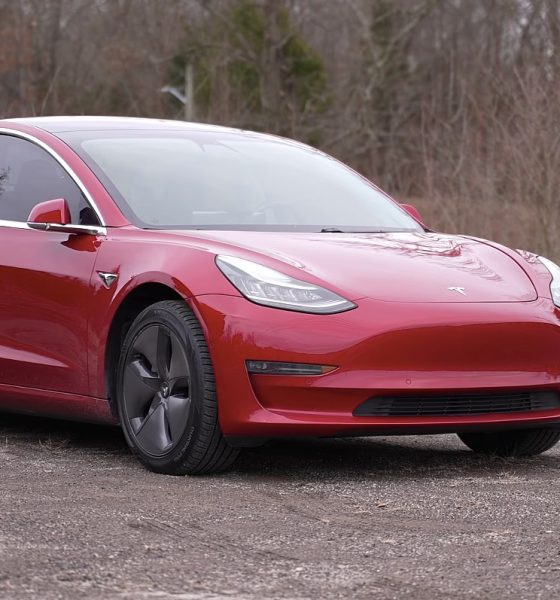

News
Tesla Model 3 loses only 2.2% of battery range after four years and 100k miles
The longevity of electric vehicles’ battery packs has always been a tricky subject. Companies like Tesla suggest that their cars’ battery packs are designed to last years, while avid EV skeptics would argue that electric vehicles would need a new battery after a few short years of ownership due to degradation. Fortunately, vehicles like the Tesla Model 3 have been around for several years now, and some can already provide valuable data.
Electric vehicle advocate Andy Slye was among the first customers of the Tesla Model 3, taking delivery of the all-electric sedan at a time when only the Long Range RWD variant was available. Since taking delivery of his Model 3 four years ago, the EV owner was able to rack up 100,000 miles in the vehicle. Over its four years in service, the Model 3 proved to be a car that definitely seems designed to go the distance.
The Model 3 owner’s overall thoughts and insights were summarized in a YouTube video, which he uploaded recently on his personal channel. Yet within the Model 3’s 100,000-mile review, the EV owner mentioned something rather remarkable. Over the four years he’s had the vehicle, and over the 100,000 miles the Tesla had traveled, the all-electric sedan had only lost 2.2% of its range. The vehicle was rated at 310 miles when it was new, and now, its full charge remains listed at 303 miles.
Of course, a lot of this is due to the fact that the 100,000-mile Model 3’s battery was well taken care of, as hinted at by the EV owner regularly plugging in the car at home using Tesla’s home charging solution. Overall, however, it’s difficult not to be impressed with the longevity of the Model 3’s battery. Considering the battery’s 2.2% degradation after four years, the Model 3 owner remarked that he is currently not expecting to replace the car’s battery over the ten years he plans on keeping the vehicle.
There are several iconic high-mileage Teslas across the globe, the most notable of which is arguably the Model S P85 driven by Germany-based Hansjörg Gemmingen, who purchased the car in 2014. As of early January 2022, the Model S road warrior had racked up 1.5 million km (932,256 miles) on its odometer. It has been an eventful road to such a feat, however, as the Model S required a battery change at 470,000 km (292,044 miles). Three electric motors were also worn out on the Model S’ journey to 1 million km (621,371 miles).
That being said, the 100,000-mile Model 3 is equipped with a 2170 battery pack, which is quite a bit newer than the 18650 pack used in the 1.5 million km Model S. Overall, it would not be surprising if Tesla’s Model 3 and Model Y 2170 batteries end up lasting very long with very little degradation. Tesla is just getting started, however, as the company is also hard at work in developing its next generation of batteries, the 4680 cells, which would make their debut in the Made-in-Texas Model Y later this year.
Don’t hesitate to contact us with news tips. Just send a message to simon@teslarati.com to give us a heads up.

News
Tesla FSD fleet is nearing 7 billion total miles, including 2.5 billion city miles
As can be seen on Tesla’s official FSD webpage, vehicles equipped with the system have now navigated over 6.99 billion miles.

Tesla’s Full Self-Driving (Supervised) fleet is closing in on almost 7 billion total miles driven, as per data posted by the company on its official FSD webpage.
These figures hint at the massive scale of data fueling Tesla’s rapid FSD improvements, which have been quite notable as of late.
FSD mileage milestones
As can be seen on Tesla’s official FSD webpage, vehicles equipped with the system have now navigated over 6.99 billion miles. Tesla owner and avid FSD tester Whole Mars Catalog also shared a screenshot indicating that from the nearly 7 billion miles traveled by the FSD fleet, more than 2.5 billion miles were driven inside cities.
City miles are particularly valuable for complex urban scenarios like unprotected turns, pedestrian interactions, and traffic lights. This is also the difference-maker for FSD, as only complex solutions, such as Waymo’s self-driving taxis, operate similarly on inner-city streets. And even then, incidents such as the San Francisco blackouts have proven challenging for sensor-rich vehicles like Waymos.
Tesla’s data edge
Tesla has a number of advantages in the autonomous vehicle sector, one of which is the size of its fleet and the number of vehicles training FSD on real-world roads. Tesla’s nearly 7 billion FSD miles then allow the company to roll out updates that make its vehicles behave like they are being driven by experienced drivers, even if they are operating on their own.
So notable are Tesla’s improvements to FSD that NVIDIA Director of Robotics Jim Fan, after experiencing FSD v14, noted that the system is the first AI that passes what he described as a “Physical Turing Test.”
“Despite knowing exactly how robot learning works, I still find it magical watching the steering wheel turn by itself. First it feels surreal, next it becomes routine. Then, like the smartphone, taking it away actively hurts. This is how humanity gets rewired and glued to god-like technologies,” Fan wrote in a post on X.
News
Tesla starts showing how FSD will change lives in Europe
Local officials tested the system on narrow country roads and were impressed by FSD’s smooth, human-like driving, with some calling the service a game-changer for everyday life in areas that are far from urban centers.

Tesla has launched Europe’s first public shuttle service using Full Self-Driving (Supervised) in the rural Eifelkreis Bitburg-Prüm region of Germany, demonstrating how the technology can restore independence and mobility for people who struggle with limited transport options.
Local officials tested the system on narrow country roads and were impressed by FSD’s smooth, human-like driving, with some calling the service a game-changer for everyday life in areas that are far from urban centers.
Officials see real impact on rural residents
Arzfeld Mayor Johannes Kuhl and District Administrator Andreas Kruppert personally tested the Tesla shuttle service. This allowed them to see just how well FSD navigated winding lanes and rural roads confidently. Kruppert said, “Autonomous driving sounds like science fiction to many, but we simply see here that it works totally well in rural regions too.” Kuhl, for his part, also noted that FSD “feels like a very experienced driver.”
The pilot complements the area’s “Citizen Bus” program, which provides on-demand rides for elderly residents who can no longer drive themselves. Tesla Europe shared a video of a demonstration of the service, highlighting how FSD gives people their freedom back, even in places where public transport is not as prevalent.
What the Ministry for Economic Affairs and Transport says
Rhineland-Palatinate’s Minister Daniela Schmitt supported the project, praising the collaboration that made this “first of its kind in Europe” possible. As per the ministry, the rural rollout for the service shows FSD’s potential beyond major cities, and it delivers tangible benefits like grocery runs, doctor visits, and social connections for isolated residents.
“Reliable and flexible mobility is especially vital in rural areas. With the launch of a shuttle service using self-driving vehicles (FSD supervised) by Tesla in the Eifelkreis Bitburg-Prüm, an innovative pilot project is now getting underway that complements local community bus services. It is the first project of its kind in Europe.
“The result is a real gain for rural mobility: greater accessibility, more flexibility and tangible benefits for everyday life. A strong signal for innovation, cooperation and future-oriented mobility beyond urban centers,” the ministry wrote in a LinkedIn post.
News
Tesla China quietly posts Robotaxi-related job listing
Tesla China is currently seeking a Low Voltage Electrical Engineer to work on circuit board design for the company’s autonomous vehicles.

Tesla has posted a new job listing in Shanghai explicitly tied to its Robotaxi program, fueling speculation that the company is preparing to launch its dedicated autonomous ride-hailing service in China.
As noted in the listing, Tesla China is currently seeking a Low Voltage Electrical Engineer to work on circuit board design for the company’s autonomous vehicles.
Robotaxi-specific role
The listing, which was shared on social media platform X by industry watcher @tslaming, suggested that Tesla China is looking to fill the role urgently. The job listing itself specifically mentions that the person hired for the role will be working on the Low Voltage Hardware team, which would design the circuit boards that would serve as the nervous system of the Robotaxi.
Key tasks for the role, as indicated in the job listing, include collaboration with PCB layout, firmware, mechanical, program management, and validation teams, among other responsibilities. The role is based in Shanghai.
China Robotaxi launch
China represents a massive potential market for robotaxis, with its dense urban centers and supportive policies in select cities. Tesla has limited permission to roll out FSD in the country, though despite this, its vehicles have been hailed as among the best in the market when it comes to autonomous features. So far, at least, it appears that China supports Tesla’s FSD and Robotaxi rollout.
This was hinted at in November, when Tesla brought the Cybercab to the 8th China International Import Expo (CIIE) in Shanghai, marking the first time that the autonomous two-seater was brought to the Asia-Pacific region. The vehicle, despite not having a release date in China, received a significant amount of interest among the event’s attendees.








